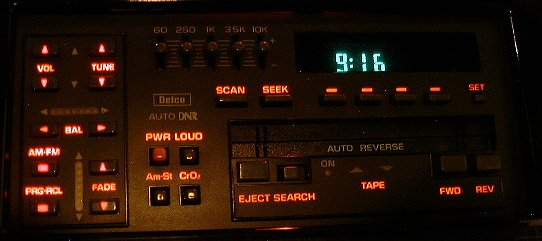1987 Pontiac Trans Am GTA
Keep in mind, when looking over this factory optional radio, that most of the available sound
systems in US-made cars before the late 90s were far from capable of delivering anything close
to 'high fidelity' sound quality. However, this particular unit is fairly decent considering
what was commonplace as far as factory-delivered radios.

I'm sure the presence of the optional amplifier/subwoofer package has a great deal to do with
my satisfaction with this system, but the radio does play a great deal clearer than the regular
factory excuses for sound systems. The graphic equalizer center frequencies are well thought-out
for the system's capabilities and allow for tailoring the sound for any situation ranging from
soft clarity to blaringly loud. The 'loudness' button does a nice job of boosting the extreme bass
and treble content to enhance low-volume listening. The tuner is fairly strong and can pick up
pretty much all stations in the listening area... and then some. As far as speakers go, the regular
in-dash 4" units were used, however the traditional 6"x9" full range speakers in the C-panel were
replaced with 4"x6" coaxial units along with 4" round subwoofers, encased in a fancy ported
enclosure using the inside of the car's panels as resonant cavities. The subwoofer was fed
not by the head unit itself, but by a separate amplifier.
 Photo courtesy of GTA Source Page
Photo courtesy of GTA Source Page
Performance-wise, as mentioned above, the fact that the low frequencies were offloaded to the
separate amplifier and subwoofers made for a great deal less distortion of the midrange and high
frequencies in most music material. When careful attention was paid to the settings on the equalizer,
some fairly deafening volume levels could be obtained, and with some pretty good clarity to boot.
Material played using the cassette tape player was optimum, as the imperfect tape medium did not
reproduce the unplayable subsonic frequencies (the resonant frequency of the subwoofer 'boxes' along
with the actual subwoofer sizes did not allow faithful and/or safe reproduction of subsonic material
often found in house/techno/dance music). Most forms of music did not suffer from this loss, and
gained in both volume and lack of low-end distortion. On the downside, the always-active DNR
(Dynamic Noise Reduction) meant the cassette unit was always automatically decreasing the
high-frequencies on soft passages in an attempt to minimize hiss and noise... a poor man's Dolby
noise reduction. Not the hot ticket for fidelity, but if after this description you're still
expecting home-entertainment-system quality from this setup, you haven't fully grasped the
patched-together nature of this system, with all its unconventional solutions to getting cheap
yet decent sound quality!

AM-Stereo:
The oddest feature on this radio is the
capability of decoding AM-Stereo radio material. We did have a stereophonic AM station around here
until sometime in the mid-to-late 90's and I have to admit it was worlds ahead of monaural AM radio,
in clarity and richness. Lack of standardization led to AM-Stereo's eventual disappearance. This
particular unit supported the C-UQAM method.



